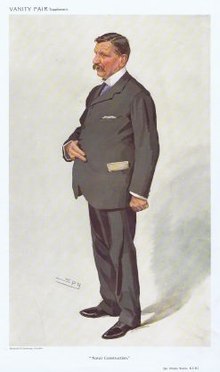Philip Watts
Sir Philip Watts KCB , FRS (born May 30, 1846 in Deptford , Kent , † March 15, 1926 in London ) was a British naval engineer and Director of Naval Construction at the time of the German-British naval competition on the eve of the First World War .
Life
Watts was born into a family with a long history of shipbuilders. He learned the shipbuilding trade at the Royal Dockyard in Portsmouth and was accepted into the Royal School of Naval Architecture and Marine Engineering in South Kensington for a four-year course at the age of 20 . He later worked for the Admiralty under William Froude . In the early 1880s he was Constructor in charge at Chatham Dockyard before he accepted a civilian position as General Manager and Naval Architect at Sir William George Armstrong's shipyard in Elswick in 1885 . Here he made a name for himself over the next 17 years as a designer of the " Elswick cruisers ", among other things , which were intended for sale to foreign navies.
In 1902 Watts was appointed as the successor to William Henry White to the Admiralty's Director of Naval Construction . Under the First Sea Lord (from 1904) John Arbuthnot Fisher , the British shipbuilding program experienced a remarkable reorientation, which was reflected in the construction of the HMS Dreadnought of 1906 and a whole series of dreadnought battleships and battlecruisers afterwards. Almost all capital ships used by the British during the Battle of the Skagerrak were built under the supervision of Watts. After retiring as Director of Naval Construction in 1912, he remained for some time as a consultant for the Admiralty. Before the outbreak of World War I, he returned to Armstrong-Whitworth , where he became the company's general manager.
Watts had been a member of the Royal Society since 1900 and was at times its vice-president. He was also a founding member of the Society for Nautical Research and a member of the Institution of Civil Engineers and the Royal Institution of Naval Architects . In 1918 he was accepted as a corresponding member of the Académie des sciences .
He died of pneumonia in his Chelsea apartment in 1926, aged 79.
literature
- Fred M. Walker: Ships and Shipbuilders: Pioneers of Design and Construction. Seaforth Publishing, 2010, ISBN 978-1-84832-072-7 .
Web links
- Philip Watts on history.inportsmouth.co.uk
Individual evidence
- ^ List of former members since 1666: Letter W. Académie des sciences, accessed on March 14, 2020 (French).
| personal data | |
|---|---|
| SURNAME | Watts, Philip |
| BRIEF DESCRIPTION | British shipbuilding architect |
| DATE OF BIRTH | May 30, 1846 |
| PLACE OF BIRTH | Deptford , Kent |
| DATE OF DEATH | March 15, 1926 |
| Place of death | London |
